HKJ
Flashaholic
[size=+3]Charger UltraFire WF-139[/size]
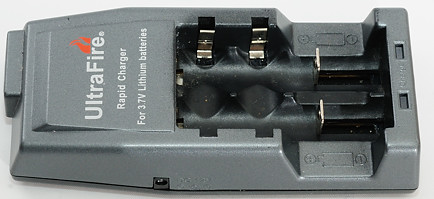
This charger has been around a long time and in many versions. One of the first version had a very bad reputation, but the current versions is better. The version I test here is from AW. The charger is a two channel charger that can fit up to two 18650 batteries. The four terminals at the sides are not connected.
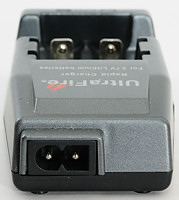
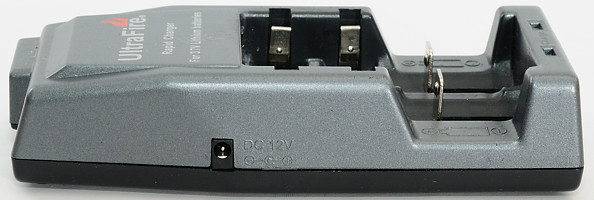
The charger has a connector for the mains lead and is sold with different mains leads depending on country. The mains supply can be from 100 to 240 VAC and 50 to 60 Hz. It can also be connected to a 12 volt source, i.e. a car.
There is two leds, they are red when charging with a occasional green flash. At all other times they are green. This means that the led will be green if a battery with to low voltage is placed in the charger!

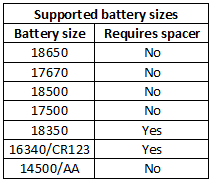
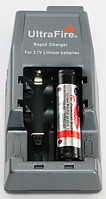
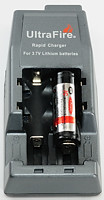
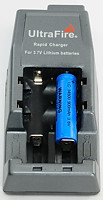
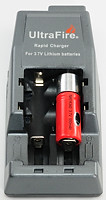
The charger can handle up to 68 mm long batteries, this does not include all brands of protected 18650 batteries (See my 18650 LiIon comparison for length of different brands).
[size=+2]Measurements[/size]
The charger uses a 150uA trickle charge for batteries below 2.25 volt.
Between 2.25 volt and 4.2 volt a constant current of 350 to 400 mA is used to charge.
When the battery goes above 4.2 volt the current is turned off (below 2uA current).
The charger will not restart charging before the battery has been removed, the voltage has been below 2.25 volt or the power has been cycled.
When charger is disconnected from power, but with a battery in, it will draw 140uA from the battery.
With two batteries the charging current is slightly reduced (less than 10% reduction).
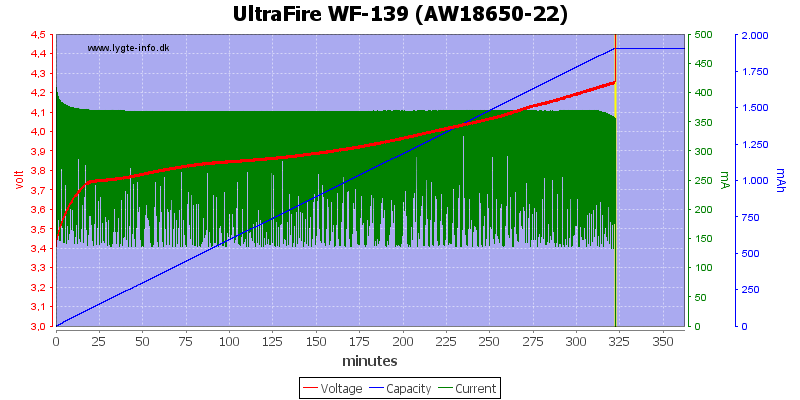
In the first example the protection in the battery is activated, because the voltage gets above 4.25 volt. This stops the charge. When the battery is removed, the voltage will drop and the protection will turn off again. The charge time is about 5½ hour.
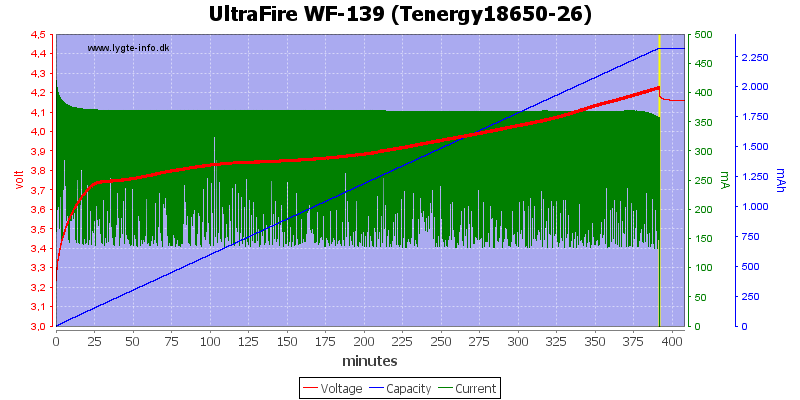
Again a 18650 battery, this time the protection does not trip and the charge turns off the regular way. The charge time is about 6½ hour.
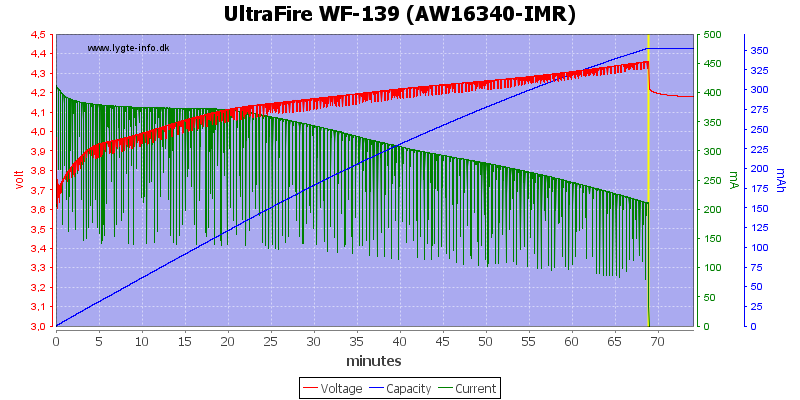
With a 16340 battery the charger is much faster, especially with this old battery with reduced capacity. In this chart it is also easy to see that the charger goes above 4.2 volt, but when the charging is turned off, the battery is exactly at 4.2 volt.
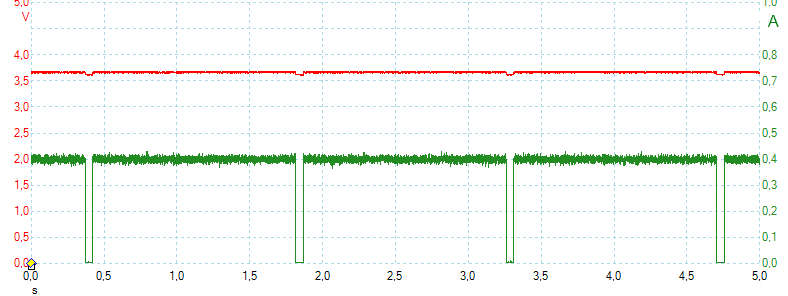
How did the charge manage to turn off at 4.2 volt without current? This can be seen in this graph, each 1.5 second the charger turns the current off for 0.05 second and then it can measure the voltage without current. Note: This graph has noise reduction applied!
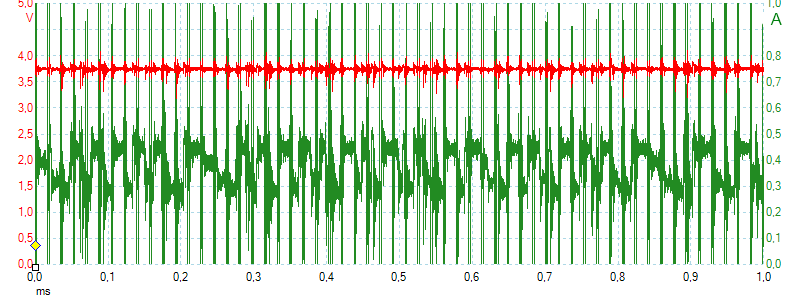
There might be a reason for measuring the voltage this way. In the above graph I have measured with noise reduction, here is the same lines without any noise reduction (but a different time scale). The current generator in the charger is generating a lot of electric noise, making it difficult to get exact measurements when it is on.
[size=+2]Conclusion[/size]
The charger does not follow the recommended charge procedure for LiIon batteries, but it does charge to 4.2 volt and then turns off. It takes a long time to charge 18650 batteries, but 16340 and 14500 are charged fast.
I believe that it is a useable charger.
[size=+3]Notes[/size]
To test if the charger is this version or the old version a DMM is required: Measure the voltage between the + and - charging terminals without a battery mounted, if it is around 5 volt, it is the new version (The old version is above 10 volt).
Another version of the WF-139 has 0 volt between + and - terminals without battery and will charge with up to 1.2 ampere, it has the same markings as any other WF-139 charger. Due to higher current this version cannot be recommended for 18350, 16340 and 14500 cells.
Here is an explanation on how I did the above charge curves: How do I test a charger

This charger has been around a long time and in many versions. One of the first version had a very bad reputation, but the current versions is better. The version I test here is from AW. The charger is a two channel charger that can fit up to two 18650 batteries. The four terminals at the sides are not connected.


The charger has a connector for the mains lead and is sold with different mains leads depending on country. The mains supply can be from 100 to 240 VAC and 50 to 60 Hz. It can also be connected to a 12 volt source, i.e. a car.
There is two leds, they are red when charging with a occasional green flash. At all other times they are green. This means that the led will be green if a battery with to low voltage is placed in the charger!






The charger can handle up to 68 mm long batteries, this does not include all brands of protected 18650 batteries (See my 18650 LiIon comparison for length of different brands).
[size=+2]Measurements[/size]
The charger uses a 150uA trickle charge for batteries below 2.25 volt.
Between 2.25 volt and 4.2 volt a constant current of 350 to 400 mA is used to charge.
When the battery goes above 4.2 volt the current is turned off (below 2uA current).
The charger will not restart charging before the battery has been removed, the voltage has been below 2.25 volt or the power has been cycled.
When charger is disconnected from power, but with a battery in, it will draw 140uA from the battery.
With two batteries the charging current is slightly reduced (less than 10% reduction).

In the first example the protection in the battery is activated, because the voltage gets above 4.25 volt. This stops the charge. When the battery is removed, the voltage will drop and the protection will turn off again. The charge time is about 5½ hour.

Again a 18650 battery, this time the protection does not trip and the charge turns off the regular way. The charge time is about 6½ hour.

With a 16340 battery the charger is much faster, especially with this old battery with reduced capacity. In this chart it is also easy to see that the charger goes above 4.2 volt, but when the charging is turned off, the battery is exactly at 4.2 volt.

How did the charge manage to turn off at 4.2 volt without current? This can be seen in this graph, each 1.5 second the charger turns the current off for 0.05 second and then it can measure the voltage without current. Note: This graph has noise reduction applied!

There might be a reason for measuring the voltage this way. In the above graph I have measured with noise reduction, here is the same lines without any noise reduction (but a different time scale). The current generator in the charger is generating a lot of electric noise, making it difficult to get exact measurements when it is on.
[size=+2]Conclusion[/size]
The charger does not follow the recommended charge procedure for LiIon batteries, but it does charge to 4.2 volt and then turns off. It takes a long time to charge 18650 batteries, but 16340 and 14500 are charged fast.
I believe that it is a useable charger.
[size=+3]Notes[/size]
To test if the charger is this version or the old version a DMM is required: Measure the voltage between the + and - charging terminals without a battery mounted, if it is around 5 volt, it is the new version (The old version is above 10 volt).
Another version of the WF-139 has 0 volt between + and - terminals without battery and will charge with up to 1.2 ampere, it has the same markings as any other WF-139 charger. Due to higher current this version cannot be recommended for 18350, 16340 and 14500 cells.
Here is an explanation on how I did the above charge curves: How do I test a charger
Last edited:

